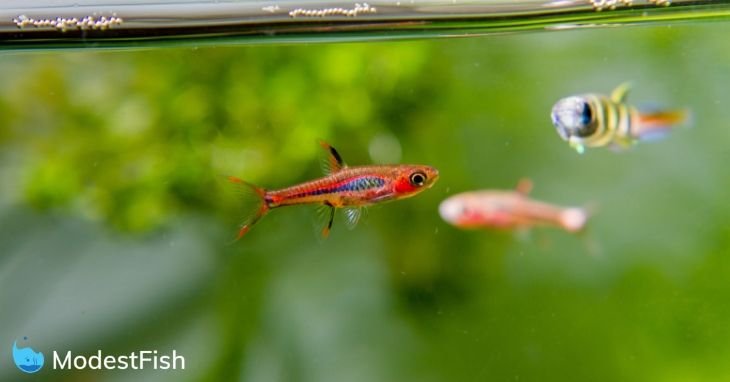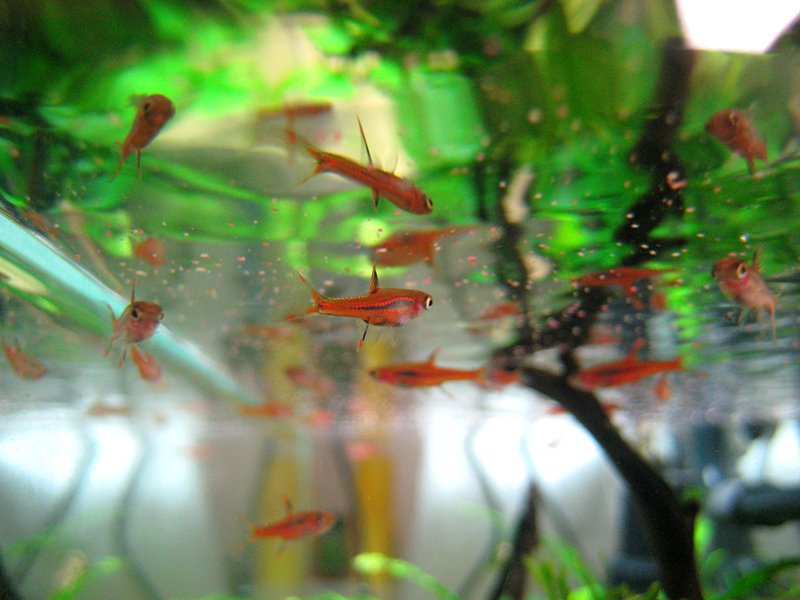[ad_1]
Chili rasboras are beautiful and adorable nano fish with interesting movement and behavior.
They’re not an overly demanding fish, but they do need to be kept in a well-established and properly maintained aquarium. So they may not be right for you if you’re a beginner.
In this care guide, I’ll discuss everything you need to know about chili rasboras, so you’ll know if they’re right for you and your tank.
Chili Rasboras Quick Stats
- Care Level: easy
- Min. Tank Size: 5 gallon (19 liter)
- Temperature: 68°-82°F (20°-28°C)
- Diet: carnivore
- Temperament: peaceful schooling fish
- Lifespan: 5-8 years
- Size: 0.5-0.75 inches (1.25-2 centimeters)
- Family: Cyprinidae
- How many can be kept together: the more, the merrier
- Scientific Name: Boraras brigittae
- Common Name: chili rasboras, mosquito rasboras
Appearance

Chili rasboras are super cute little fish, perfect for a nano tank.
They are slim-bodied with strongly pointed fins and a forked tail.
Males are bright, bright red. Females are also red, but are more subdued.
Males and females both sport black markings that run from the mid-body to the tail. Sometimes the markings form a single stripe down either the side of the body. Other times, the stripe is broken up, making it look like a series of dashes.
The fins and tail are translucent black with opaque red and black dots.
This species has very large eyes relative to its body size, something that helps make them even more adorable.
Species Profile
In the wild, chili rasboras are native to the island of Borneo in Indonesia.
Borneo is in a tropical region with average temperatures between 79°F-95°F (26°C-35°C).
These fish inhabit slow-moving blackwater creeks and rivers, where they feed primarily on insect larvae, particularly mosquito larvae.
Their typical habitat has water that’s darkly stained from tannins that leach out from fallen leaves. In natural areas, the water is typically shaded from above by the dense jungle growth of Borneo’s rainforests.
The shade from trees, and the dark, tannin-stained water, makes even open areas dim, with limited visibility.
Chili rasboras travel together in large groups, depending on the “safety in numbers” strategy employed by many fish.
The rasboras school together, moving in and out of patches of dense plants along the banks of waterways, looking for insect larvae, baby shrimp and other tiny crustaceans, like daphnia.
They spawn almost continuously, scattering their eggs into the tangles of aquatic plants that hug the riverbanks, leaving the fry to fend for themselves.
How to Set Up a Chili Rasboras Tank

Tank Size
These fish are tiny little guys! So, they don’t need a very big tank.
This species needs to be kept in a group of at least five, but it’s always the more, the merrier.
Even so, they are so small that you can keep a school of six or seven in a 5 gallon (19 liter) aquarium.
Just keep in mind, though, with fish tanks, bigger is always better. A bigger school of fish, with a larger space to move around in, will have more interesting behavior.
And being in a large group helps these relatively shy little fish feel more at ease.
Filtration
Chili rasboras are not very strong swimmers. They’re just so small and a constant, strong current will exhaust them.
So, you don’t want a filter that puts out a ton of water flow.
I recommend a sponge filter for a chili rasboras tank; it is 100% my first choice of filters for small and delicate species like this one.
Sponge filters are:
- Low flow
- Cheap
- Easy to set up
- Easy to maintain
- Great mechanical filtration
- Excellent biological filtration
For more in-depth information about sponge filters, see our comprehensive article here.
Water Parameters
- Temperature: 68°F-82°F (20°C-28°C)
- Ammonia/Nitrite: 0
- Nitrate: >30 ppm
- pH: 6.0-8.0
- GH: 4-10 dGH
- KH: 3-15 dKH
Heater
Chili rasboras can tolerate a wide range of temperatures, but will be more active if kept in a tank that ranges from 75°F-82°F (24°C-28°C).
I would recommend adding a heater to your rasboras tank, especially if you want to keep any other tropical species of nano fish in the tank with them.
For smaller tanks, 15 gallons (57 liters) and under, I recommend one of the Fluval P Series preset heaters.
I like that they’re shatterproof and so simple to use. Just make sure to use the right size heater for your tank. Check with Fluval’s recommendations about sizing.

Fluval P25 Submersible Aquarium Heater for Up to 6 Gallons, 25 Watts
Last update on 2023-04-04 / Commissions Earned / Images from Amazon Product Advertising API
For larger tanks, 20 gallons (76 liters) and up, I recommend the Fluval E Series adjustable electronic heaters.
I’m running three of these heaters right now, all of my living room tanks have them.
I can honestly say, after over 2 years using them, these are the best heaters that I have ever had. They’re the only heaters I’ll be buying in the future as other older ones conk out.
I like the big digital thermometer display on these heaters; they change color to alert you if the temp has gotten too high or low.
It’s easy to set and adjust these heaters anytime you want.
And they have the power needed to efficiently maintain the water temperature.

Fluval E200 Advanced Electronic Heater, 100-Watt Heater for Aquariums up to 65 Gal., A773,Black
Last update on 2023-04-04 / Commissions Earned / Images from Amazon Product Advertising API
Substrate
This species of fish is a mid/top-dwelling species, so they don’t really interact with the substrate all that much.
But, they will look better against a dark-colored substrate.
Fish tend to mute their colors to better blend in with a light-colored substrate, making them look washed out.
Conversely, fish will darken their colors to blend into a dark-colored substrate and look bolder and more colorful.
Lighting
Chili rasboras originate from blackwater environments, slow-moving waterways stained dark from tannins leached into the water column from fallen tree leaves.
Blackwater fish, like Bettas and killifish, are most comfortable in dim lighting. In fact, chili rasboras, Bettas and killifish all have very large eyes, all the better to see in dim conditions.
If your tank has bright lighting, it can be overwhelming and stressful for your rasboras. Consider adding some floating plants, like frog bit or red root floater.
Floating plants will block some of the light coming into the tank and will make the fish feel less vulnerable to threats from above.
And as a bonus, floating plants are a great way to decrease nitrates in the water column.
Plants and Decor
In the wild, this species lives within the densely packed aquatic plants that grow along the riverbanks.
If at all possible, it’s best to mimic this in the aquarium. Tall stem plants that reach the top of the water will be particularly appreciated.
Chili rasboras will gladly flit in and out between the plant stems throughout the day.
If you don’t have a green thumb, no worries, nice tall artificial plants that reach the surface of the water will be just fine.
Decor with small caves and/or swim-through areas will offer hidey holes the fish can retreat to when they feel threatened.
Create a mix of densely planted areas and open swimming areas. Your chili rasboras will migrate back and forth between the two throughout the day.
Chili Rasboras Diet
In nature, chili rasboras are tiny little predators that scour their habitats for any signs of insect larvae, crustaceans or tiny worms.
In the aquarium, it’s best to feed them a varied diet that is rich in meaty sources of food. High quality protein sources, combined with color enhancing ingredients, will help produce healthy and vibrantly colored fish.
Omega One Color Mini Pellets are sized for tiny fish like rasboras. Salmon and whole herring are the first ingredients and it contains marigold extract that helps enhance coloration.

Omega One Color Mini Pellets, Sinking, 3.5 oz
Last update on 2023-04-05 / Commissions Earned / Images from Amazon Product Advertising API
This Ultra Fresh Micro Pellets food contains sword prawn, a great source for pigments that makes red fish especially vibrant. It also throws in spirulina and seaweed, vitamin rich plant-based ingredients with high nutritional content.

Ultra Fresh Tetra Fish Food, Slow Sinking, All Natural Ingredients, Wild Sword Prawns, Spirulina, Natural Color Enhancement, Small Granules for Small Fish, Tropical Micro Pellet 1.87 oz
Last update on 2023-04-04 / Commissions Earned / Images from Amazon Product Advertising API
Chili Rasboras Breeding
Chili rasboras are prolific breeders. If tank conditions are good, they will spawn continuously.
If there is enough cover in the tank, like Java moss, guppy grass, pearl weed or plastic breeding grass, some fry should be able to survive long enough to become free swimming.
Getting chili rasboras to breed is simple, but their babies are particularly tiny when they hatch, so raising the fry is complicated and difficult.
The babies will need to be placed in their own grow out tank so that they are not eaten by adults. They’ll need a sponge filter and a heater.
You’ll need to culture infusoria to feed the fry for the first few weeks. Then you will need to transition to larger live foods, like vinegar eels and microworms. After a few weeks of these intermediate foods, the fry should be able to eat freshly hatched brine shrimp.
Once the fry are 3-4 months old, they can be introduced into the main tank with the adult rasboras.
As you can see, it is an involved process. Culturing live food for your fish can be a fun and rewarding aspect of the hobby, for some folks. But, it’s definitely not for everyone.
Growing a wide variety of live foods, and getting the timing right so that you have the appropriately sized foods ready at the correct time, takes serious skill and dedication. I would not recommend this undertaking for a novice hobbyist.
Chili Rasboras Tank Mates
When looking for tank mates for chili rasboras, the biggest consideration is size. Even peaceful fish will gulp down a tank mate that is easily swallowed. Fish have a very simple philosophy: “If it fits in my mouth, it must be food.”
So, you need peaceful tank mates that are also small and that won’t try to eat your rasboras for lunch.
Some good candidates are:
I would highly recommend adding some cherry or Amano shrimp to your chili rasboras tank.
Shrimp are great for cleaning up algae as well as uneaten food that the fish don’t find.
If the cherry shrimp breed, which they likely will, the chili rasboras will be able to eat some of the freshly hatched shrimplets. But, with adequate cover in the tank, many of the baby shrimp will evade predation and grow too large for the fish’s tiny mouths.
Shrimp are a helpful cleanup crew in your tank that adds very little to the bioload.
Plus, they’re really interesting to watch, as they go about, living their shrimpy little lives.
Snails are also a peaceful tank mate that can help reduce algae and waste in the aquarium.
Are Chili Rasboras Right for You?
Chili rasboras are beautiful and adorable nano fish with interesting movement and behavior.
They’re not an overly demanding fish, they just need to be in a well-established, properly maintained aquarium.
Simple maintenance, like weekly water changes, will keep the water clean and stable, and the fish will thrive.
They are not a good choice for a new hobbyist’s first tank, but more experienced keepers should find them simple to care for.
Overall, this species is an outstanding nano fish. Tiny, but impactful.
I hope you find this article helpful.
I wish you and your fish the very best!
[ad_2]
Source by [author_name]



